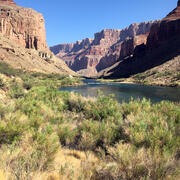Native Plants
Native Plants
Filter Total Items: 7
SBSC: Providing Unbiased Actionable Science & Information to Support Natural Resource Management Needs of the U.S. & Department of the Interior Priorities
The U.S. Geological Survey Southwest Biological Science Center (SBSC) is uniquely positioned in the Colorado River Basin to provide sound information, specialized expertise, and innovative tools to support the management and sustained use of natural resources on public and Tribal lands in the Southwest U.S.
Vegetation monitoring: How one square meter can tell the story of 255 river miles along the Colorado River
The goal of SBSC's Grand Canyon Monitoring and Research Center’s (GCMRC) riparian vegetation monitoring program is to assess changes and trends in plant species composition and cover and relate those changes to river hydrology, climate, geomorphology, and the operations of Glen Canyon Dam.
RAMPS: Restoration Assessment & Monitoring Program for the Southwest
The Restoration Assessment and Monitoring Program for the Southwest (RAMPS) seeks to assist U.S. Department of the Interior (DOI) and other land management agencies in developing successful techniques for improving land condition in dryland ecosystems of the southwestern United States. Invasion by non-native species, wildfire, drought, and other disturbances are growing rapidly in extent and...
SBSC Tribal Partnerships
The Southwest Biological Science Center (SBSC) conducts and provides scientific information as part of our mission and Federal Trust Responsibility to strengthen relationships and build partnerships with sovereign tribal nations. Here, we highlight a few examples of projects with tribal partners.
The iconic giant saguaro cactus in the Sonoran Desert
The saguaro cactus ( Carnegiea gigantea) is a keystone species that grows only in the Sonoran Desert of northern Mexico and the southwestern United States. The USGS’ Southwest Biological Science Center is working to better understand the species’ biological features, its role as a keystone species that supports greater than 100 other plant and animal species, and its responses to extreme drought...
Genomic Research Supporting Western Conservation
In the western United States (U.S.), there are many regionally restricted, rare species resulting from complex demographic and ecological processes through time. In addition to the inherent risks associated with being rare (i.e., having few individuals spread over a limited area that could be disproportionately affected by chance events), anthropogenic disturbances are increasing in magnitude...
RestoreNet: Distributed Field Trial Network for Dryland Restoration
Starting in 2017, U.S. Geological Survey (USGS) researchers and land managers are co-producing a network of restoration field trial sites on Department of Interior (DOI) and surrounding lands in the southwestern U.S. The network systematically tests restoration treatments across a broad range of environmental gradients. Each site in the network is used to test suitable seed mixes and treatments...








